The seven-year quest to produce an official technical explanation for the destruction of World Trade Center Buildings 1, 2, and 7 represents an unparalleled case study in “expectation bias."
NFPA 921: Guide for Fire and Explosion Investigations, which serves as the national guide for fire and explosion investigations in the United States, defines “expectation bias” as follows:
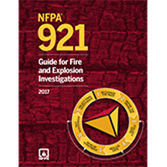
“Expectation bias is a well-established phenomenon that occurs in scientific analysis when investigator(s) reach a premature conclusion without having examined or considered all of the relevant data. Instead of collecting and examining all of the data in a logical and unbiased manner to reach a scientifically reliable conclusion, the investigator(s) uses the premature determination to dictate investigative processes, analyses, and, ultimately, conclusions, in a way that is not scientifically valid. The introduction of expectation bias into the investigation results in the use of only that data that supports this previously formed conclusion and often results in the misinterpretation and/or the discarding of data that does not support the original opinion. Investigators are strongly cautioned to avoid expectation bias through proper use of the scientific method.”
NFPA 921 also explicitly urges investigators to avoid presumption in the formulation of hypotheses:
“Until data have been collected, no specific hypothesis can be reasonably formed or tested. All investigations of fire and explosion incidents should be approached by the investigator without presumption…until the use of scientific method has yielded testable hypotheses, which cannot be disproved by rigorous testing.”
As discussed below, the two official investigations of the WTC destruction flagrantly violated these principles, resulting in incomplete hypotheses that are wholly unsupported by any evidence and that ignore most of the relevant evidence.
The WTC FEMA Building Performance Study
Although investigators claimed that they were certain as to the cause of the Twin Towers’ destruction one week after the event — “Already there is near-consensus as to the sequence of events that led to the collapse of the World Trade Center,” R. Shankar Nair told the Chicago Tribune on September 19 — they were reportedly at a loss to explain the destruction of WTC 7.
“Engineers and other experts, who quickly came to understand how hurtling airplanes and jet fuel had helped bring down the main towers, were for weeks still stunned by what happened to 7 World Trade Center,” The New York Times reported on November 29. “We know what happened at 1 and 2, but why did 7 come down?” said William Baker, who was a member of the team assembled by the American Society of Civil Engineers (ASCE) and given authority under FEMA to investigate the World Trade Center destruction.
Six months later, on May 1, 2002, FEMA released its report, titled World Trade Center Building Performance Study: Data Collection, Preliminary Observations, and Recommendations. As implied in the title, the report did not attempt to provide a definitive explanation for the destruction of WTC 7 (nor for WTC 1 and WTC 2). Instead, it posited scenarios in general terms and recommended further investigation to definitively determine the exact causes.
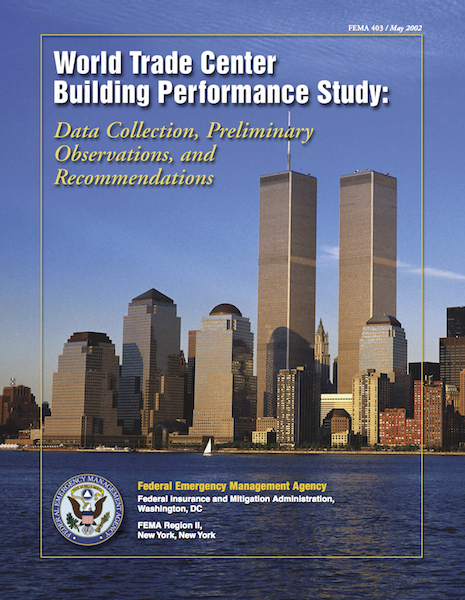
Regarding WTC 7, FEMA reported that there was “no clear evidence of where or on which floor the initiating failure occurred,” but it put forward a number of “potential scenarios” involving fires on various floors on the east side of the building. Noting that those areas contained “little if any fuel” that would be required to feed fires hot enough and long-lasting enough to weaken the structure, the report suggested “a hypothesis based on potential rather than demonstrated fact” that diesel fuel from the building's emergency generators was the source of fire. Like the “pancake theory” for WTC 1 and WTC 2, the diesel fuel hypothesis reflected common thinking at the time but was later ruled out by the National Institute of Standards and Technology (NIST). [Emphasis added.]
Then, toward the end of the report, FEMA observed:
“The specifics of the fires in WTC 7 and how they caused the building to collapse remain unknown at this time. Although the total diesel fuel on the premises contained massive potential energy, the best hypothesis has only a low probability of occurrence.” [Emphasis added.]
Thus, instead of pursuing the most likely hypothesis for WTC 7’s destruction — given that no steel-framed high-rise had ever collapsed due to fire and that the destruction of WTC 7 resembled a classic controlled demolition — FEMA posited a hypothesis that involved an unprecedented cause, for which it found no supporting evidence, and that it acknowledged had “only a low probability of occurrence.”
The NIST Investigation
Amid a growing sense that the FEMA investigation was insufficient for the task of conducting a full-scale investigation, NIST began planning its own investigation in October 2001 to eventually succeed FEMA’s. The NIST investigation was announced on August 21, 2002, and was scheduled to take 24 months.
In its final plan, released in August 2002, NIST acknowledged that fire had never caused the total collapse of a high-rise building prior to September 11, 2001. Nonetheless, it pursued this hypothesis without reservation, even going so far as to treat it as fact: “The WTC Towers and WTC 7 are the only known cases of total structural collapse in high-rise buildings where fire played a role.”
After releasing progress reports in December 2002 and May 2003 that provided little detail on its WTC 7 analysis, NIST finally announced a working hypothesis for WTC 7 in its June 2004 progress report. NIST suggested that an initial local failure somewhere below Floor 13, caused by fire and/or structural damage, triggered a column failure and subsequent vertical progression of failures up to the east penthouse. The resulting damage, NIST hypothesized, set off a horizontal progression of failures across the lower floors, resulting in disproportionate collapse of the entire building.
NIST’s working hypothesis for the destruction of WTC 7 was further elaborated in a Popular Mechanics article from March 2005, which said: “NIST researchers now support the working hypothesis that WTC 7 was far more compromised by debris than the FEMA report indicated.... NIST investigators believe a combination of intense fire and severe structural damage contributed to the collapse.”
In its April 2005 progress report, NIST announced for the first time that its report on WTC 7 would be released as a supplement to its report on WTC 1 and WTC 2, with a draft report scheduled for October 2005 and the final report slated for December 2005. Notably, NIST addressed the subject of the controlled demolition hypothesis for the first time — but only in relation to WTC 7: “NIST has seen no evidence that the collapse of WTC 7 was caused by bombs, missiles, or controlled demolition.” NIST did not describe what methods it used to search for evidence of controlled demolition.
Then, in September 2005, at a three-day technical conference where NIST released its final report on WTC 1 and WTC 2, it announced that its report on WTC 7 would be further postponed, with the technical work being completed in January 2006, the draft report for public comment scheduled for May 2006, and the final report finished in June 2006.
But NIST ended up significantly extending that timeline. A report that in June 2005 was set for release by the end of that year would end up being released almost three years later. In a March 2006 New York Magazine interview, NIST lead investigator Dr. Shyam Sunder provided some possible insight into why the report was delayed so long. When asked about WTC 7, Dr. Sunder said that NIST had some “preliminary hypotheses,” then added, “But truthfully, I don’t really know. We’ve had trouble getting a handle on building No. 7.” This was three and a half years into NIST’s WTC investigation.
That same month, NIST awarded a new contract to Applied Research Associates for the job of determining the location and cause of the initiating event and the subsequent series of failures that led to the total collapse of WTC 7. The contract was appended in August 2006 to include the task of determining if any “hypothetical blast event or events” contributed to the destruction of WTC 7.
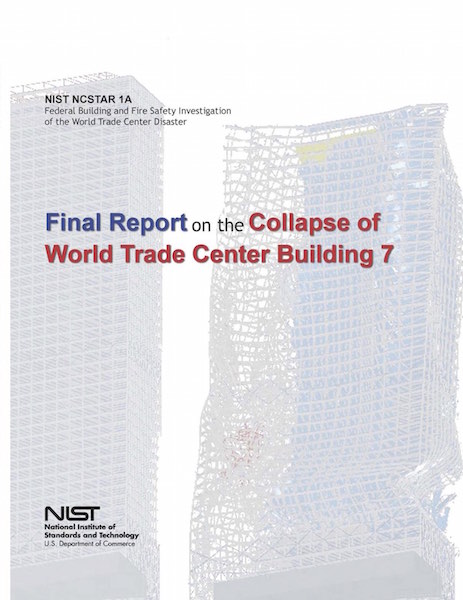
In August 2008, the draft for public comment was finally released. That November, the final report was published. Diesel fuel fires and structural damage were no longer hypothesized to have contributed to the collapse. Instead, normal office fires were said to be the sole cause, making it “the first known instance of the total collapse of a tall building primarily due to fires.”
As researcher Frank Legge said of WTC 1 and WTC 2 two months before the release of NIST’s draft report on WTC 7, “the fire based official explanation is a series of events, like links in a chain, while the explosive based explanation is a parallel set of scientific studies of evidence…. If an explanation is in the form of a chain it is only necessary to prove one link wrong to destroy the case.” The same can be said of NIST's explanation for the destruction of WTC 7, except that the chain of events alleged by NIST is even more elaborate. The table below is a summary of NIST’s “Probable Collapse Sequence” for WTC 7.
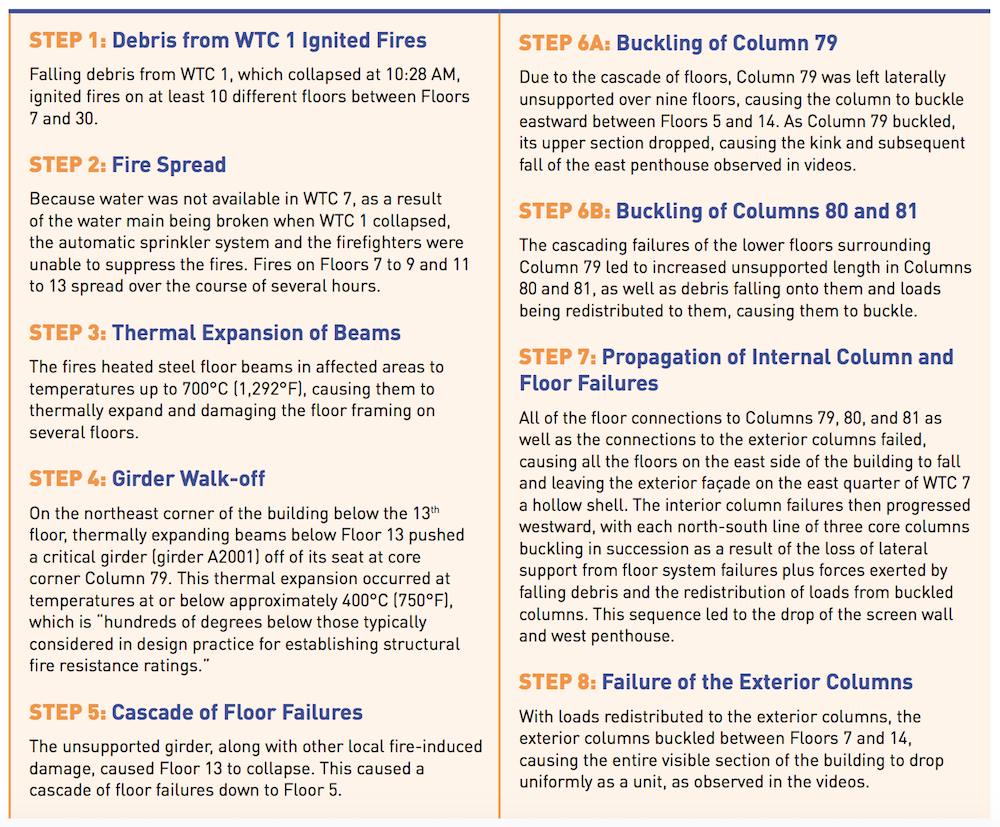 A summary of NIST’s “Probable Collapse Sequence” for WTC 7.
A summary of NIST’s “Probable Collapse Sequence” for WTC 7.
Below we focus on NIST’s superficial attempt to rule out the use of explosives in the destruction of WTC 7 and on the most glaring issues in NIST’s modeling of WTC 7.
For discussion of NIST’s failure to explain WTC 7’s free fall, see Free-Fall Acceleration. For more extensive critiques of NIST’s explanation for the destruction of WTC 7, see the items under “More on this Subject.”
Hypothetical Blast Scenarios and Thermite Use
The only substantive analysis that NIST performed regarding the hypothesis of controlled demolition was its consideration of “hypothetical blast scenarios” for the destruction of WTC 7, carried out under a contract with Applied Research Associates beginning in August 2006.
NIST’s analysis started with identifying a hypothetical blast event involving the minimum amount of explosive material required to fail Column 79. It determined that to be a linear-shaped charge consisting of nine pounds of RDX. From there, it performed analyses to assess how much window breakage and noise would result — and whether it was feasible for someone to plant such explosives in the building.
NIST concluded the following:
- [T]he minimum charge (lower bound) required to fail a critical column (i.e., Column 79) would have produced a pressure wave that would have broken windows on the north and east faces of the building near Column 79. The visual evidence did not show such breakage....
- [T]he noise level at a distance of 1/2 mile would have been on the order of 130 dB to 140dB.... People on the street would have heard 9 lb of RDX go off a mile away....
- Preparations for a blast scenario would have been almost impossible to carry out on any floor in the building without detection....2
NIST’s analysis of “hypothetical blast scenarios” is a textbook example of straw man tactics, where an argument is constructed and then refuted to give the impression that an opponent’s argument has been defeated, when in fact the refuted argument is not the opponent’s.
Proponents of the controlled demolition hypothesis have seldom, if ever, argued that a high explosive such as RDX was used to destroy WTC 7. Rather, as the evidence examined in High-Temperature Thermitic Reactions and Steel Sulfidation strongly suggests, the leading hypothesis is that an explosive form of thermite called “nano-thermite” — possibly in combination with some form of explosives and other incendiaries — was used to destroy WTC 7. Using nano-thermite, instead of the more powerful RDX, would allow a perpetrator to demolish a building while concealing the fact that he had planted explosives.
Even though NIST was fully aware of nano-thermite technology3 and it knew that the leading hypothesis of controlled demolition involved some form of thermite, as evidenced by its FAQ (see below), it selected a “straw man” substance — RDX — for its hypothetical blast event. Thus, its analyses of the window breakage and noise associated with RDX are irrelevant.
Furthermore, the evidence examined in Explosions contradicts NIST’s claim that explosions were not observed by eyewitnesses or captured on video. Indeed, explosions were observed by eyewitnesses and captured on video. As one person at the scene recounted, “[I]t looked like there was a shockwave ripping through the building and the windows all busted out.”
In suggesting that “[o]ccupants, support staff, and visitors would have noticed evidence of such activities [i.e., placing charges],” NIST also assumed that the planting of explosives would have happened without the knowledge of someone responsible for security at WTC 7. But proponents of the controlled demolition hypothesis have seldom suggested that the planting of explosives could have been accomplished without the knowledge and complicity of someone in charge of security at WTC 7.
NIST’s analysis also assumed that a demolition of WTC 7 would have been executed in the manner of a typical commercial controlled demolition. But according to researcher Jim Hoffman, “[E]xplosive devices could have been disguised as or concealed within legitimate equipment.... Numerous such possibilities are afforded by the properties of energetic materials.” In fact, Hoffman argues, “Any such job would have been far simpler than the structural retrofit of the CitiCorp Tower” — a feat the owners successfully managed in 1978 without their tenants knowing about it, after learning that the building was likely to topple in a hurricane.4
Thermite Instead of Nano-Thermite
NIST advanced a second straw man argument when it tackled the idea in both of its FAQ documents (one for the Twin Towers, the other for WTC 7) that thermite or thermate alone was used to destroy the buildings. NIST gave the following answer in response to the question of whether it tested the steel for residues of thermite:
“[Thermite] burns slowly relative to explosive materials.... 0.13 pounds of thermite would be required to heat each pound of a steel section to approximately 700 degrees Celsius.... [M]any thousands of pounds of thermite would need to have been placed inconspicuously ahead of time.... This makes it an unlikely substance for achieving a controlled demolition.” 5
Once again, NIST constructed an easily refutable argument that is not the argument actually advanced by proponents of the controlled demolition hypothesis. It is well known that thermite and thermate alone do not possess the explosiveness needed to account for a large amount of the evidence of explosions that NIST itself ignored.
Had it been NIST’s genuine intention “to determine whether explosives could have been used to cause the collapse[s],” it would have tested the steel for explosives and thermite residues.
NIST's Computer Modeling
Because most of the WTC steel was destroyed before it could be inspected, the NIST WTC investigation had to rely almost entirely on computer modeling. The modeling performed by NIST failed — effectively disproving its hypothesis — in two ways:
1. It did not replicate the observed structural behavior of the buildings, and
2. It required significant manipulation — in other words, applying information known to be factually unsupported — in order to achieve collapse initiation.
As discussed in Free-Fall Acceleration, NIST asserted that the three stages of collapse progression it measured for WTC 7 were “consistent with the results of the global collapse analyses discussed in Chapter 12 of NIST NCSTAR 1-9” (where NIST presented the results of its computer model).
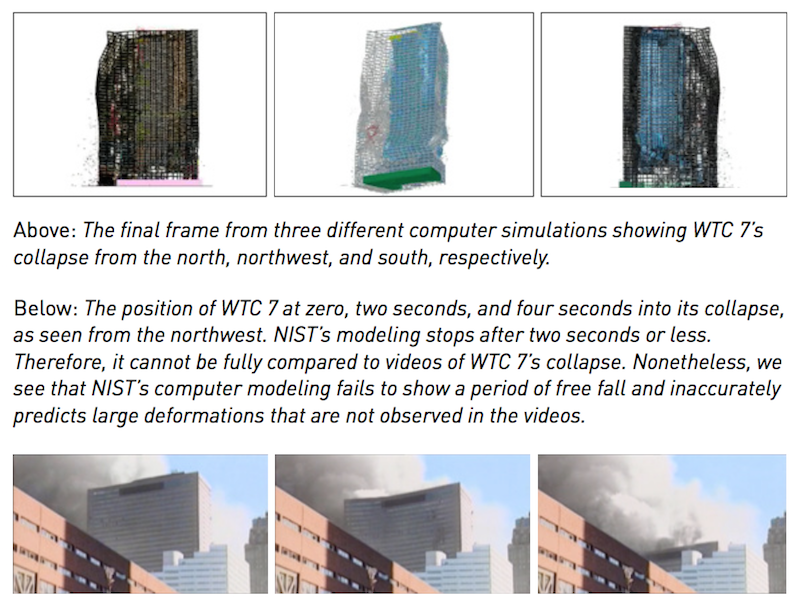
However, when we view the model,6 we see — besides the fact that it stops after only two seconds, which is well before the end of the collapse — that it fails to replicate the observed structural behavior in two important ways. First, it fails to show the 2.25 seconds of free fall that NIST finally acknowledged. Second, it shows large deformations of the building’s exterior structure that are not observed in the videos.
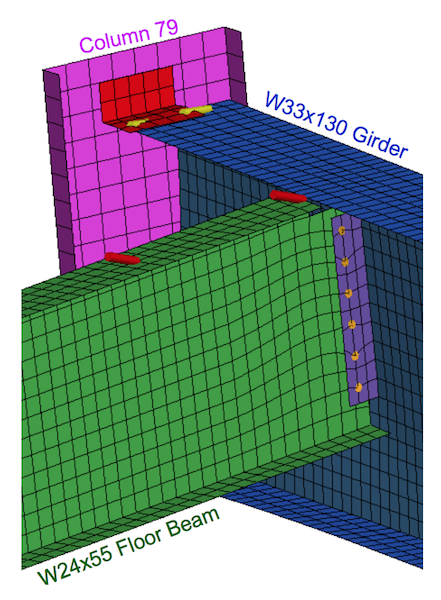 This illustration from the NIST report shows the mechanism that NIST claims initiated the collapse of WTC 7: Floor beams (green) thermally expanded and pushed girder A2001 (blue) off of the seat connecting it to Column 79 (purple).
This illustration from the NIST report shows the mechanism that NIST claims initiated the collapse of WTC 7: Floor beams (green) thermally expanded and pushed girder A2001 (blue) off of the seat connecting it to Column 79 (purple).
NIST also had to manipulate its modeling significantly just to get the collapse to initiate. Specifically — in order to make the floor beams under Floor 13 expand and push the critical girder (A2001) off its seat and allegedly trigger a total collapse of the building — NIST took the following steps:
1. It ignored the fact that the fire in the northeast section of Floor 12 had burned out over an hour before it supposedly caused the beams under Floor 13 to expand.
2. It omitted shear studs on girder A2001 that would have prevented the girder from being pushed off its seat.
3. It inexplicably heated the floor beams but not the floor slab above them, thus causing the floor beams, but not the slab, to expand. This caused the shear studs connecting the floor beams and the slab to fail, which allowed the floor beams to move independently of the slab.
4. It ignored the fact that the floor beams could expand no more than 5 3/4 inches — less than the 6 1/4 inches required to push the girder off its seat — before shortening, caused by sagging, would overtake expansion.
5. It omitted web/flange stiffeners that would have prevented the bottom flange of the girder from folding (even if the beams had somehow expanded 6 1/4 inches).
Had NIST modeled WTC 7 accurately, the mechanism that it claimed initiated the collapse would not have been feasible.
Endnotes
[1] Legge, Frank: “9/11 and Probability Theory,” Journal of 9/11 Studies (June 2008).
[2] NIST: NCSTAR 1-9, p. 357.
[3] Ryan, Kevin: “The Top Ten Connections Between NIST and Nano-Thermites,” Journal of 9/11 Studies (July 2008).
[4] Hoffman, Jim: "Frequently Asked Questions: Controlled Demolition," 9-11Research.WTC7.net. http://911research.wtc7.net/faq/demolition.html.
[5] NIST: Questions and Answers about the NIST WTC Towers Investigation, Question #22.
[6] http://wtcdata.nist.gov/gallery2/v/NIST+Materials+and+Data/Computer+Simulations/WTC7_Structural+Response
[7] NIST public affairs officer Michael Newman confirmed in email correspondence with researcher David Cole on October 25, 2013, that the web/flange stiffeners on girder A2001 were omitted from NIST’s computer model of WTC 7.


